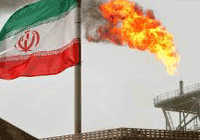
Iran unfazed by sanctions, but wait
Singapore, February 22, 2012
Iran has probably yet to feel the pain of Western sanctions on its oil revenues, as the 17 percent gain in crude prices since December has largely offset the decline in exports. But the key word here is yet.
Ian Taylor, the head of the world's top oil trader Vitol, said the Iranians are "probably quite close to winning" based on the current numbers. That might explain why Tehran remains defiant on its nuclear programme while the US and Europe press harder for crude buyers to curb purchases.
Iran has so far lost about 500,000 barrels a day of exports, roughly a fifth of its total, based on information from refiners and other officials.
The bulk of this is due to a halving of the 700,000 barrels that Europe buys, with the rest coming from cuts by China, India, Japan and other Asian buyers.
Assuming an oil price of $100, Iran would earn about $250 million a day on its prior export levels of 2.5 million barrels a day.
If the volume of exports has dropped to 2 million barrels, but the price has risen to around $120 a barrel, Iran's revenue has only slipped to about $240 million a day -- in other words, not really enough to make much of a difference.
However, assuming Europe makes good on its pledge to completely cut off Iranian imports, then Iran could lose a further 350,000 barrels a day, currently worth $42 million.
Tehran may also see less imports from Southeast Asia and possibly even Africa, and, contrary to their bullish rhetoric, the Iranians are finding it hard to find alternative buyers.
Taking more Iranian crude seems to falling into the too-hard basket for many Asian refiners, as it seems the Iranians aren't yet offering discounts and financial sanctions are making it difficult to process payments. Not all refineries can also process Iran's sour grades.
If Iran is then only able to sell 1.5 million barrels a day, then the consequences might be quite severe. Assuming benchmark Brent oil doesn't rise much above $120, Iran's daily revenue could drop to around $180 million a day, or about $65.7 billion a year.
This is 28 percent lower than the $91.3 billion that it would have earned if exports were 2.5 million barrels a day and oil was $100 a barrel.
Add to this loss of oil revenue to inflation that is above 20 percent, a sharp currency devaluation and increasing trade difficulties because of the sanctions, and it becomes clearer that the risks are mounting for Iran.
For this reason the Iranians will want oil prices to remain elevated, and the best way of achieving this is to keep escalating the crisis so that the headlines make investors nervous, and they keep bidding up prompt crude prices amid fears of a supply crunch.
For the Western powers, it becomes clearer that their interests are best served by making sure the Iranians lose at least 1 million barrels a day of oil exports, while reassuring the market about supply continuity.
Brent crude at around $120 a barrel is probably fairly close to the maximum pain level the developed world can take currently, given Europe's perilous economy and the nascent recovery in the United States.
It was also likely that $120 a barrel is the level at which demand destruction started to kick in last year, and that may well be the case again.
It always feels like a bit of a cop out to write that things are evenly poised, but currently that does appear to be the best description of where the world stands vis-a -vis efforts to force Iran to open its nuclear programme to full scrutiny.
The sanctions so far haven't hurt the Iranians too much, but they have the potential to inflict serious damage soon, and at a time when the increase in oil prices is raising the risk of renewed recession in the developed world.
In this high-stakes game, neither side has yet reached their pain threshhold, and it's still far from certain who will get there first. - By Clyde Russell, a Reuters market analyst (The views expressed are his own)







